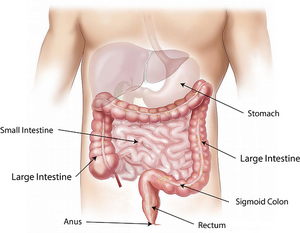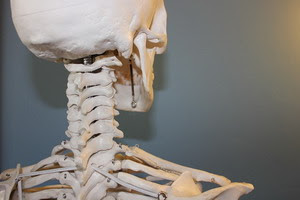
About a week ago I read a book on vagus nerve function and clinical applications. The vagus nerve has been described as the rest and digest nerve that comes out from the base of your skull and travels down to most all of your internal organs like the heart, lungs, and digestive system. This would normally be pretty dry clinical stuff that no normal person would find interesting. However, the information presented was exciting (in a chiropractic nerd sort of way) because it provided a whole new way of looking at this subject.
About 25 years ago a professor Porges from the University of Illinois at Chicago presented findings that what everyone has believed about the vagus nerve for the last several thousand years is inaccurate. He demonstrated that in fact the vagus nerve is actually two different and distinct nerves that have very opposite effects. The old theory is accurate for lower life forms, but for humans and other mammals it is not. We mammals developed special nerves to support our capacity for social engagement that when engaged suppress the fight/flight/freeze responses to danger. Higher life forms learned to create safety through connection to others, and the new vagus (termed the ventral vagus) was the nerve that controlled this response.

Think about this for a moment. We have a whole nerve system for opposing fear, rage, and withdrawal by increasing social engagement. That is pretty amazing. In this day and age of chronic stress with everyone’s health being destroyed by stress, to discover that we have on board a system for relieving our reactions to stress by opening up connection to others. This is actual hardwired nerve physiology, not some airy-fairy psychological theory. What is more, this function can directly be measured by the effect it has on our heart rhythm, know as our heart rate variability. The more engaged we are the more the timing between our heart beats varies in response to our environment. This nerve function can also be seen with classic cranial nerve tests. This is the test where the doctor looks down your throat and has you say ahhhh. If this nerve is working right, the soft palate tissue on both sides of your uvula (that thing that hangs down at the back of your throat) will lift up evenly. If it does not lift up or only one side lifts up, then the vagus nerve is not working correctly.
This nerve also directly correlates with the function of several other cranial nerves that relate to social connection and communication – the nerves to the facial muscles for our expressions, the neck muscles and eye muscles for tracking expressions of others, voice and throat muscles, and the nerves that modify our hearing.

We are wired to be social animals because it is our socialness that gave us a survival advantage over competing life forms.
Probably the most cool thing presented in this book is a simple technique for turning this neurologic system on so we can turn off or turn down our fight or flight feelings and our withdraw and separate feelings. The implications are profound and many of these implications and clinical applications are presented in this book. Such things as working with anxiety, PTSD, depression, autism, ADHD, and many more. Many of the results are simply amazing.
One little application that caught my attention is its usefulness for patients that deal with a sliding hiatal hernia messing with their stomach and digestion. A portion of this ventral vagal nerve goes to the esophagus. When we are in flight or fight, the muscle coat around the esophagus contracts and shortens up the esophagus, actually pulling up on the stomach and creating the sliding hiatal hernia. By engaging/ turning on the ventral vagus, the esophagus relaxes and the hiatal hernia settles down. Hiatal hernias have always

been a vexation to me. I can reset them by pulling down the stomach and resetting the diaphragm, but they tend to come right back when the person gets stressed. Now I can show the patient how to reengage the ventral vagus nerve function any time so they can fix their own hiatal hernia as soon as it happens. Here is how to do it:
Atlas Reset Basic Exercise
Your atlas controls the blood flow to the brain stem and the midbrain where all your emotions, coordination, and nerves for controlling your organs live. When your atlas is under tension due to stress (real or imagined) it twists and reduces blood flow to these brain regions. This exercise is to rebalance your atlas and open up the blood flow to your brain. The eye movements trigger movements and tension releases in the tiny muscles between the skull and the atlas.

1. Interlace your fingers and place your hands behind your head cradling the back of your skull. Let your elbows relax out to the sides.
2. Keeping your head centered and pointed forward,

shift your eyes to the right as far as you can and hold that eye position for 30 to 60 seconds. You are waiting for your breath to release with a sigh, a swallow, or a yawn.
3. After your breath releases, then shift your eyes as

far as you comfortably can to the left and hold that position for 30 to 60 seconds waiting for the same breath release.
4. All done. Note any improvements in the movement of your neck.
The first few times you do this it is best to start out laying down. The idea is to let your skull be supported by your hands so that you relieve the weight of the skull pushing down on the vertebra. This helps free up the space between the skull and the first vertebra, the atlas. The eye movements trigger the rebalancing of the tiny muscles in this area which in turn re-centers your

atlas vertebra. The main blood supply to the base of the brain and the regions controlled by the vagus nerve passes through the atlas as the vertebral artery before ducking up into the brainstem. If the atlas is out of place, it restricts some of this blood flow to the brain and triggers anxiety. Resetting the atlas this way opens up that blood flow and stimulates the ventral vagus function. This also calms down the part of the brain for flight or fight and the portion for withdrawal and disassociation. It takes us out of survival mode and into here and now social engagement.
This simple technique can be used anytime and as often as needed. This is a form of self care that is really easy to do and has a huge impact. I was excited to share it with you because it will empower you to immediately help not only your necks, but your stress, your digestion, and possibly your relationships. If you are able to be in a positive socially engaged neurologic state, then you have a much greater chance of actually enjoying the people you encounter.
If you are interested in reading the book yourself, the title is “Accessing the Healing Power of the Vagus Nerve” by Stanley Rosenberg. I got it here on Amazon.